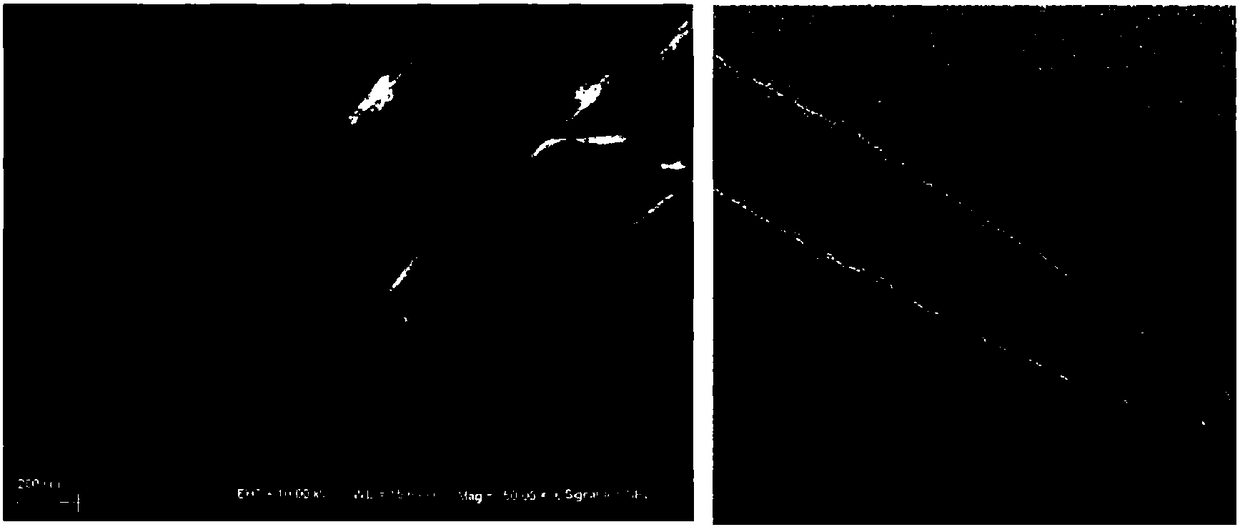Room-temperature high-sensitivity ammonia sensitive element based on tungsten oxide-polypyrrole core-sheath nano-wires
A technology of sensitive ammonia-sensitive components and tungsten oxide nanowires, which is applied in the field of high-sensitivity ammonia-sensitive components at room temperature, and can solve problems such as unstable performance of core-shell materials
- Summary
- Abstract
- Description
- Claims
- Application Information
AI Technical Summary
Problems solved by technology
Method used
Image
Examples
Embodiment 1
[0033] (1) Preparation of tungsten oxide nanowires by solvothermal method
[0034]Add tungsten hexachloride powder into 60ml of cyclohexanol, and stir it magnetically for 20 minutes to completely dissolve the tungsten hexachloride powder to obtain a uniform solution with a concentration of tungsten hexachloride of 0.005mol / L. Transfer the cyclohexanol solution of tungsten hexachloride to a high-pressure reaction kettle lined with polytetrafluoroethylene. After sealing, place the reaction kettle in an oven to heat for solvothermal reaction. The working temperature of the oven is 200°C, and the heating time is for 6h.
[0035] (2) Cleaning of tungsten oxide nanowires
[0036] After the solvothermal reaction was completed, the autoclave was naturally cooled to room temperature, and the reaction kettle was taken out, and the blue solid-liquid reactant in the reaction kettle was centrifuged, and the speed of the centrifuge was set at 5000r / min. The solid obtained by centrifugatio...
Embodiment 2
[0043] (1) Preparation of tungsten oxide nanowires by solvothermal method
[0044] Add tungsten hexachloride powder into 60ml of cyclohexanol, and stir magnetically for 10 minutes to completely dissolve the tungsten hexachloride powder to obtain a uniform solution with a concentration of tungsten hexachloride of 0.005mol / L. Transfer the cyclohexanol solution of tungsten hexachloride to a high-pressure reaction kettle lined with polytetrafluoroethylene. After sealing, place the reaction kettle in an oven to heat for solvothermal reaction. The working temperature of the oven is 180°C, and the heating time is for 9h.
[0045] (2) Cleaning of tungsten oxide nanowires
[0046] After the solvothermal reaction was completed, the high-pressure reactor was naturally cooled to room temperature, and the reactor was taken out, and the blue solid-liquid reactant in the reactor was centrifuged, and the centrifuge speed was set to 4000r / min. The solid obtained by centrifugation was washed ...
Embodiment 3
[0054] (1) Preparation of tungsten oxide nanowires by solvothermal method
[0055] Add tungsten hexachloride powder into 60ml of cyclohexanol, and stir it magnetically for 40 minutes to completely dissolve the tungsten hexachloride powder, and obtain a uniform solution with a concentration of tungsten hexachloride of 0.005mol / L. Transfer the cyclohexanol solution of tungsten hexachloride to a high-pressure reactor lined with polytetrafluoroethylene. After sealing, place the reactor in an oven to heat for solvothermal reaction. The working temperature of the oven is 220°C, and the heating time is for 7h.
[0056] (2) Cleaning of tungsten oxide nanowires
[0057] After the solvothermal reaction was completed, the autoclave was naturally cooled to room temperature, and the reaction kettle was taken out, and the blue solid-liquid reactant in the reaction kettle was centrifuged, and the speed of the centrifuge was set at 6000r / min. The solid obtained by centrifugation was washed ...
PUM
| Property | Measurement | Unit |
|---|---|---|
| Length | aaaaa | aaaaa |
| Thickness | aaaaa | aaaaa |
| Diameter | aaaaa | aaaaa |
Abstract
Description
Claims
Application Information
 Login to View More
Login to View More - R&D
- Intellectual Property
- Life Sciences
- Materials
- Tech Scout
- Unparalleled Data Quality
- Higher Quality Content
- 60% Fewer Hallucinations
Browse by: Latest US Patents, China's latest patents, Technical Efficacy Thesaurus, Application Domain, Technology Topic, Popular Technical Reports.
© 2025 PatSnap. All rights reserved.Legal|Privacy policy|Modern Slavery Act Transparency Statement|Sitemap|About US| Contact US: help@patsnap.com



